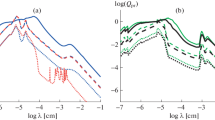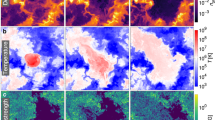Abstract
This work is divided into 13 sections and 2 appendices, and aims to elucidate the accretion mechanism, which operates via image-theory forces, whenever two interstellar dust grains come close together. Section 1 is an introduction. Section 2 proposes that the distribution of interstellar grains be taken asn(r) ∝r −4 to avoid distortion of the 3K microwave background by radiation from spinning grains. Section 3 examines each of three types of image force accretion processes, finding them to be dominant compared to radiation or gravitational forces by at least a factor of 1019. Section 4 states that only grains made of conducting material (e.g., graphite, ice, iron) are involved in image theory. Section 5 presents reasons for believing that two grains should coalesce on impact. Section 6 examines the motion of charged interstellar grains in Hi and Hii regions. Section 7 demonstrates, by way of four examples involving dust grains ofr=10−7 cm up tor=10−4 cm, that the image effects on conducting grains are not trivial, and that the dynamics involved is not to be compared at all with elementary Coulomb interaction of two changes. Section 8 concludes that accretion with not take place in Hi clouds if thermal (equipartition) velocities prevail among the dust particles. section 9 examines grain interactions in Hii regions: here, following an argument due to Spitzer, consideration is given to the case of a population of dust grains all streaming in the direction of the local magnetic field B at velocities of order 0.1 km s−1. It is shown that accretion takes place effectively, leading to the formation of interstellar ‘grit’, meaning grains of mass 10−8 to 10−7 gm, radius ≃ 0.1 mm; and leaving also a population ofr≳10−6 cm grains, which are observed in polarization and extinction measurements. The existence of the latter is now a deduction and not an ad hoc postulate, as previously, and implies a distribution of the general formn(r) ∝r −3mean , in approximate agreement with that of Section 2. Section 10 considers the accretion mechanism as a cascade process. Section 11 shows that the existence of grains in space ofr ≃ 10−6 cm rules out an origin in supernova or galactic explosions, and supports a passive origin, perhaps in red giants or Mira variables. Section 12 discusses the implications of the results found for polarization observations and cosmogony, the latter being given a new foundation in which planets of different composition form automatically from a solar nebula. Section 13 is a conclusion.
Similar content being viewed by others
References
Bailley, V. A.: 1964,Nature 201, 1202.
Bandermann, L. W.: 1972,Monthly Notices Roy. Astron. Soc. 160, 321–338.
Bleaney, B. I. and Bleaney, B.: 1965,Electricity and Magnetism, 2nd edn., Oxford Univ. Press, London, 764 pp.
Bowyer, C. G., Mack, J., and Lampton, M.: 1970,Nature 225, 125–127.
Bromage, G. E.: 1971,Nature 230, 172–175.
Chiao, R. Y. and Wickramasinghe, N. C.: 1972,Monthly Notices Roy. Astron. Soc. 159, 361–372.
Clemmow, P. C. and Dougherty, J. P.: 1969,Electrodynamics of Particles and Plasmas, Addison-Wesley Ltd., London, 457 pp.
Donn, B. and Krishna Swamy, K. S.: 1969,Nature 224, 570.
Donn, B., Stecher, T., and Wickramasinghe, N. C.: 1966,Astrophys. J. 145, 949–951.
Duley, W. W.: 1970,Nature 227, 1277.
Dunham, T.: 1939,Proc. Amer. Phil. Soc. 81, 277–293.
Eddington, A. E.: 1929,Matter in Interstellar Space, BBC Publications Ltd., London, 27 pp.
Eddington, A. E.: 1930,The Internal Constitution of the Stars, Dover Publications Ltd., New York.
Gilman, R. C.: 1973,Monthly Notices Roy. Astron. Soc. 161, short communication (3 p.).
Gilra, D. P.: 1971,Nature 229, 237–241.
Ginzburg, V. L.: 1965, in I. Robinson, A. Schild, and E. L. Schucking (eds.),Quasi-Stellar Sources and Gravitational Collapse, Univ. Chicago Press, Chicago and London, p. 286.
Hackwell, J. A., Gehrz, R. D., and Woolf, N. J.: 1970,Nature 227, 822–823.
Harrison, B. K., Thorne, K. S., Wakano, M. and Wheeler, J. A.: 1965,Gravitation Theory and Gravitational Collapse, Univ. of Chicago Press, Chicago and London, p. 84.
Harwit, M.: 1970,Nature 226, 61–62.
Henry, R. C. and Carruthers, G. R.: 1970,Science 170, 527–531.
Hoyle, F. and Wickramasinghe, N. C.: 1968,Nature 218, 1126–1127.
Hoyle, F., Wickramasinghe, N. C., and Reddish, V. C.: 1968,Nature 218, 1124–1126.
Hoyle, F. and Wickramasinghe, N. C.: 1969,Nature 223, 459–462.
Hoyle, F. and Wickramasinghe, N. C.: 1970a,Nature 226, 62–63.
Hoyle, F. and Wickramasinghe, N. C.: 1970b,Nature,227, 473–474.
Krishna Swamy, K. S. and Donn, B.: 1969,Nature 224, 788–789.
Landau, R.: 1970,Nature 226, 1040–1041.
Mack, J. E.: 1970,Nature 228, 543.
Manning, P. G.: 1970a,Nature 226, 829–830.
Manning, P. G.: 1970b,Nature,227, 1121–1123.
Manning, P. G.: 1972,Nature 240, 547.
Martin, P. G.: 1971,Monthly Notices Roy. Astron. Soc. 153, 279–285.
Martin, P. G.: 1972a,Monthly Notices Roy. Astron. Soc. 155, 283–291.
Martin, P. G.: 1972b,Monthly Notices Roy. Astron. Soc. 158, 63–78.
Martin, P. G.: 1972c,Monthly Notices Roy. Astron. Soc. 159, 179–190.
Martin, P. G., Illing, R., and Angel, J. R. P.: 1972,Monthly Notices Roy. Astron. Soc. 159, 191–201.
Nandy, K. and Seddon, H.: 1970a,Nature 226, 63–64.
Nandy, K. and Seddon, H.: 1970b,Nature 227, 264–265.
Naranan, S. and Shah, G. A.: 1970,Nature 225, 834–836.
Okuda, H. and Wickramasinghe, N. C.: 1970,Nature 226, 134–135.
Reddish, V. C.: 1971,Nature 232, 40–41.
Rees, M.: 1971, in R. K. Sachs (ed.),General Relativity and Cosmology, 1969 Varenna Lectures, Academic Press, New York and London, p. 327.
Schmidt, M.: 1971,Observatory 91, No. 985, 209–214.
Slysh, V. I.: 1969,Nature 224, 159–160.
Spitzer, L.: 1941,Astrophys. J. 93, 369–379.
Spitzer, L.: 1968,Diffuse Matter in Space, J. Wiley Interscience Inc., New York, 262 pp.
Velovykin, G. P.: 1970,Nature 225, 254.
Webster, A. S.: 1970,Nature 228, 44.
Wesson, P. S.: 1973,Quart. J. Roy. Astron. Soc. 14, 9–64.
Wickramasinghe, N. C.: 1967,Interstellar Grains, Chapman and Hall Ltd., London, 154 pp.
Wickramasinghe, N. C.: 1969,Nature 224, 656–658.
Wickramasinghe, N. C.: 1970a,Nature 225, 145–147.
Wickramasinghe, N. C.: 1970b,Nature 227, 265–266.
Wickramasinghe, N. C.: 1970c,Nature 227, 587–588.
Wickramasinghe, N. C.: 1970d,Nature 228, 540–542.
Wickramasinghe, N. C.: 1970e,Nature 228, 544.
Wickramasinghe, N. C.: 1971,New Scientist 50, 694–696.
Wickramasinghe, N. C., Donn, B. D., and Stecher, T. P.: 1966,Astrophys. J. 146, 590–593.
Wickramasinghe, N. C. and Nandy, K.: 1970a,Monthly Notices Roy. Astron. Soc. 153, 205–227.
Wickramasinghe, N. C. and Nandy, K.: 1970b,Nature 227, 51–53.
Wickramasinghe, N. C.: 1972,Monthly Notices Roy. Astron. Soc. 159, 269–287.
Author information
Authors and Affiliations
Rights and permissions
About this article
Cite this article
Wesson, P.S. Accretion and electrostatic interaction of interstellar dust grains; Interstellar grit. Astrophys Space Sci 23, 227–255 (1973). https://doi.org/10.1007/BF00647661
Received:
Issue Date:
DOI: https://doi.org/10.1007/BF00647661




